
FRA L-D Study Suggests Restored Routes
Written by David Peter Alan, Contributing Editor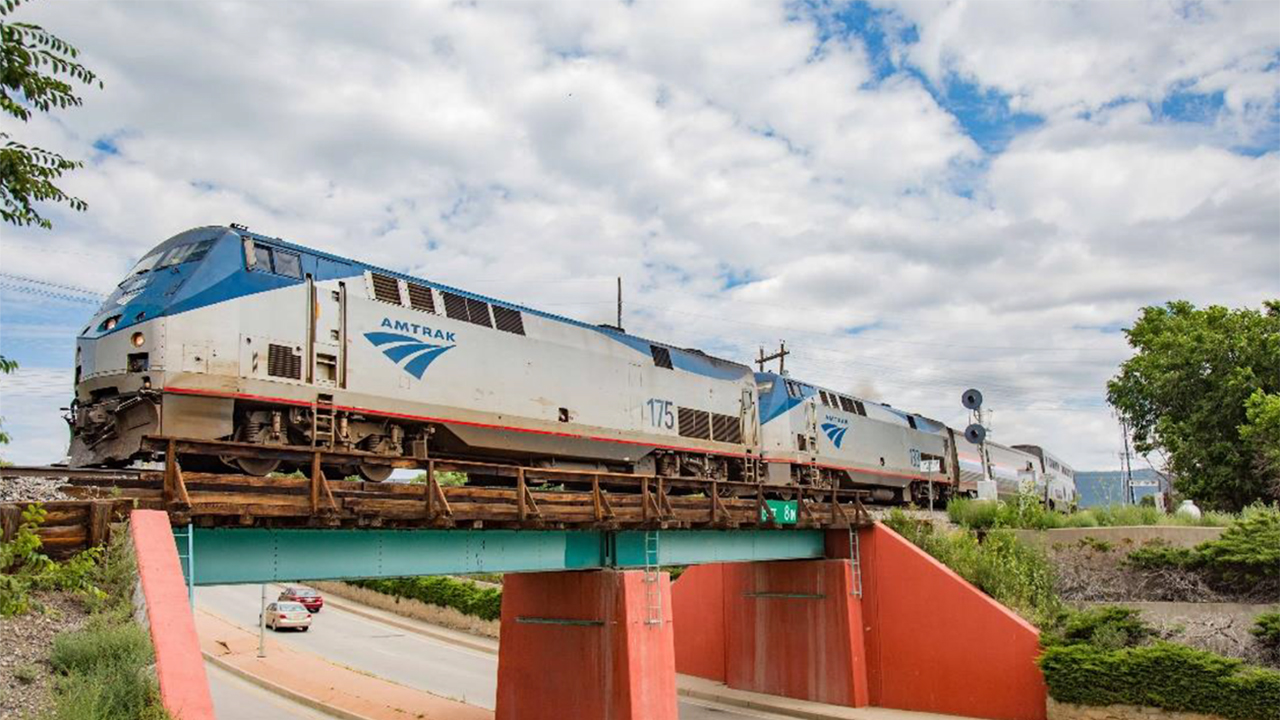
Amtrak photo
The Federal Railroad Administration (FRA), which is looking toward adding more routes to the nation’s skeletal long-distance passenger train network, revealed the proposed new routes, many of which either ran before Amtrak was founded in 1971 or during Amtrak’s early days, or were discontinued at the time Amtrak took over intercity passenger trains, or even earlier.
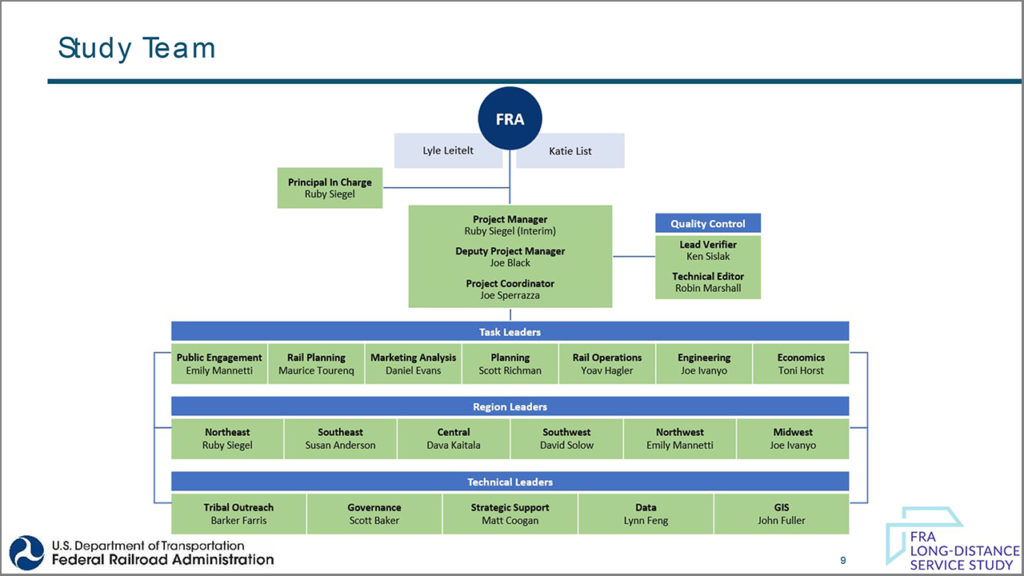
The FRA presented the proposed routes and gave detailed information about the study on a website devoted to it: https://fralongdistancerailstudy.org/meeting-materials/. The study group considered potential routes in the Northeast, Southeast, Midwest, Northwest, Southwest, and Central (from Texas north to Kansas and east to Mississippi) regions. States that have connections to two adjoining regions were involved with studying potential routes in both.
The list of routes just released constitutes the third phase of a four-phase program, the Route Identification phase. It is anticipated that the study group will suggest “Recommended Actions” during the coming spring. The FRA is accepting feedback at [email protected]., but only until March 8. All materials cited here can be found on the FRA study website.
According to an FRA presentation, “The Infrastructure Investment and Jobs Act (IIJA) of 2021 requires the FRA to conduct a study to evaluate the restoration of daily intercity rail passenger service along any Amtrak Long-Distance routes that were discontinued, and any Amtrak Long-Distance routes that occur on a nondaily basis. FRA may also evaluate potential new Amtrak Long-Distance routes, including with specific attention provided to routes in service as of April 1971 but not continued by Amtrak.”
In a section headlined Long-Distance Service Study Expectations, the material released included a list of study characteristics:
- Focused on Long-Distance Network.
- Assessment of routes more than 750 miles.
- Focused on Amtrak as service provider.
- Service frequencies to meet Long-Distance markets.
- Utilization of existing rail corridors.
- Conventional rail/technology.
Under “What this Study is NOT,” those characteristics were listed as:
- A “National Rail Plan.”
- Assessment of State-Supported routes, identifying other service providers.
- High frequency service.
- Identifying new “greenfield” alignments.
- High-speed or other emerging technologies.
“Technical Outputs” are slated to included “market demand and operations and maintenance (O&M) costs that emphasize the benefits and costs of both the existing and an expanded long-distance network” and identifying “passenger-service specific projects.”
The first three routes selected by the Corridor ID Program were announced in December 2023. They included daily operation of the Cardinal and the Sunset Limited. Amtrak currently operates both trains on tri-weekly schedules and has done so for decades. The other potential route, advocated by the Big Sky Passenger Rail Authority in Montana, is the North Coast Limited route, which was called the North Coast Hiawatha when it ran as an Amtrak train from 1972 until 1979. The FRA materials also said, “Step 1 of the program requires sponsors to develop a scope, schedule and cost estimate for preparing, competing or documenting its service development plan.”
The legislative considerations governing the study:
- Serving Large and Small Communities.
- Focus on Rural Communities.
- Enhancing Connectivity.
- Reflecting Public Engagement.
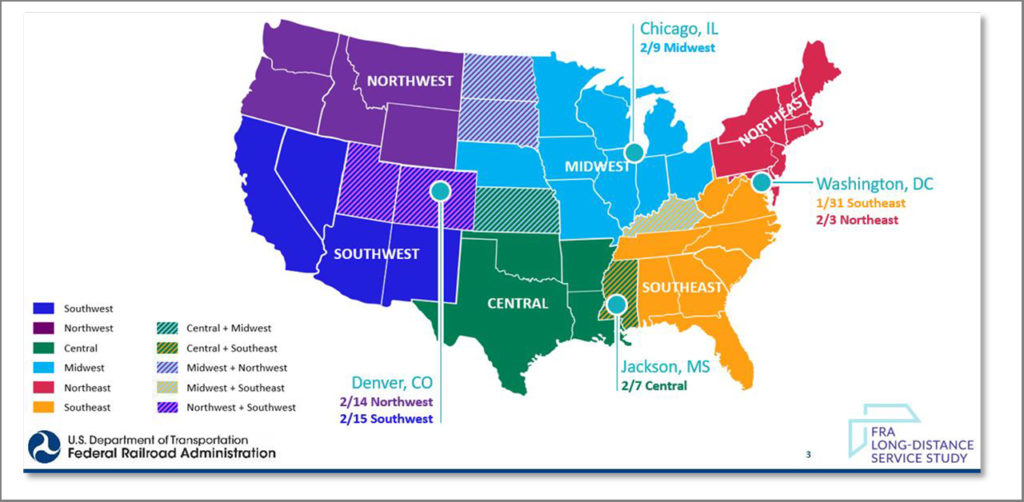
The materials found on the study website go into detail about study methodology, and about meetings held during 2022 and 2023. They also cover a variety of other topics pertinent to the choice of suggested routes.
The study started with the “Baseline Network” as a starting point. It includes the current Amtrak network with four additions:
- Brightline between Miami and Orlando (service to Orlando Airport began on September 22, 2023).
- Gulf Coast Passenger Rail between New Orleans and Mobile (service could start as soon as late in 2024, but it is unlikely to happen that soon, and it faces a political challenge in Mobile).
- Twin Cities – Milwaukee – Chicago (a second train on the part of the Empire Builder route between Chicago and St. Paul).
- The first minimum operable segment (MOS) of California High-Speed Rail between Bakersfield and Merced, now under construction.
The “Discontinued Network” under consideration included trains that operated until Amtrak started in 1971, as well as routes lost in 1979 and after that, as recently as 2005. Combining the “Proposed Network of Preferred Routes” taken primarily from the Discontinued Network and the Baseline Network of existing Amtrak routes plus a few additions would yield a relatively robust U.S. passenger rail network, the likes of which have not been seen in the past six decades. All trains would run daily, including the Sunset Limited and Cardinal, which would be restored to daily service.
The “Proposed Network of Preferred Routes” includes the following O/D pairs:
- Chicago – Miami.
- Dallas/Fort Worth – Miami.
- Denver – Houston.
- Los Angeles – Denver.
- Phoenix – Minneapolis/St. Paul.
- Dallas/Fort Worth – New York.
- Seattle – Denver.
- San Antonio – Minneapolis/St. Paul.
- San Francisco – Dallas/Fort Worth.
- Detroit – New Orleans.
- Denver – Minneapolis/St. Paul.
- Seattle – Chicago.
- Dallas/Fort Worth – Atlanta.
- El Paso – Billings.
Some of these pairs are already served by Amtrak, but the intermediate stops suggested by the study are different from those currently served. There are also some combinations that include route segments that have not hosted passenger trains for 60 years.
Routes that have been suggested:
Chicago – Miami: This is essentially the route of the Floridian, which was discontinued in 1979, except that it would serve Chattanooga and Atlanta, unlike its predecessors that ran on the historic Louisville & Nashville (L&N) and south of Atlanta. From Atlanta, the route would go to Jacksonville through Macon and Waycross, Georgia. Options include running from Atlanta to Savannah through Macon (discontinued in 1971 and proposed again as a new state-supported route), Atlanta to Savannah through Augusta, Macon to Jacksonville bypassing Savannah, and using the historic Florida East Coast main south of Jacksonville, where Brightline has operating rights.
Dallas/Fort Worth – Miami: The portion of the route between Dallas and Shreveport has been proposed as part of a new route between Dallas and Meridian, Mississippi, connecting there with the Crescent to and from New York. The segment between Shreveport and New Orleans was part of the old Louisiana Eagle route on the Texas & Pacific that was discontinued in 1963. The segment between New Orleans and Jacksonville was the old Gulf Wind on the L&N and Seaboard Railroad, discontinued in 1971. It returned from 1993 until 2005 as the eastern portion of the Sunset Limited. That train ran to Orlando and was briefly extended to Miami in the late 1990s, and the current suggestion is to run it on the FEC/Brightline route. The rest of the Meridian – Dallas route through Shreveport is under consideration, and other routes that have not run before are proposed. One is New Orleans – Houston on the Sunset Limited route, then to Dallas on Union Pacific, which ran most recently from 1988 until 1995. The other would run from Jacksonville to Savannah on the line now used for Florida service, to Augusta and Atlanta, and then on the Crescent route to New Orleans.
Denver – Houston: This route would serve a part of the country that now has no passenger trains but also has a growing population. The route would run south of Denver on historic Santa Fe (now BNSF) track to Trinidad and then through Amarillo to Fort Worth. From there it would proceed to Houston. Other segments mentioned: Houston – San Antonio on the Sunset route, and Fort Worth – San Antonio on the Texas Eagle route, could add connecting trains.
Los Angeles – Denver: This route would restore the Desert Wind and the Pioneer, both of which were discontinued in 1997. The former ran from Los Angeles to Salt Lake City through Las Vegas, while the latter route included the segment between Salt Lake City or Ogden and Denver, through Wyoming. It appears that the backup move to get to and from Cheyenne would be restored, and the route would add Wyoming to the list of states with passenger trains. The historic Denver & Rio Grande that is now part of the California Zephyr route on UP is shown, and the segment southward from Denver would connect with today’s Southwest Chief on BNSF (historic Santa Fe). The segment between Flagstaff and Phoenix would be added, in accordance with restoring Sunset service to that city.
Phoenix – Minneapolis/St. Paul: The eastbound run would start on the new segment between Phoenix and Flagstaff, a historic Santa Fe branch, now part of BNSF. The part from Flagstaff to Kansas City is part of BNSF’s Southern Transcon, where the San Francisco Chief and Grand Canyon trains ran before Amtrak. The part from Kansas City to the Twin Cities has not seen a passenger train since the 1960s. Stopping at Sioux Falls would bring a passenger train to South Dakota for the first time since then.
Dallas/Fort Worth – New York: This seems like an incongruous routing, since trains to East Coast cities historically originated from Chicago, St. Louis and New Orleans, not west of there. The proposed route would use the current Heartland Flyer segment to Oklahoma City, and then the historic Frisco line (now BNSF) through Springfield, Mo. to St. Louis. It would then follow the route of the National Limited (discontinued in 1979) to Pittsburgh and the Pennsylvanian route to New York. The one change from the 1970s route is that the train would not stop at Richmond, Ind. between Indianapolis and Dayton, but would make a longer trip to include Cincinnati. Other possible services would serve more tribal lands in Oklahoma, going through Tulsa between Fort Worth and Kansas City. Elsewhere, the segment between Kansas City and St. Louis is served by the Missouri River Runner trains; Newton – Kansas City by the Southwest Chief route. The segment between Oklahoma City and Newton has been proposed as an extension of the Heartland Flyer in Amtrak’s ConnectsUS plan. Further east, the segment between Cleveland and Pittsburgh is on the Capitol Limited route, and service between Cleveland and Cincinnati (3C+D) was also proposed in Amtrak’s ConnectsUS plan for 2035.
Houston – New York: Only the end segments of that route are served by Amtrak today. Houston – New Orleans is on the Sunset Limited route. Roanoke – New York is on the Northeast Corridor (NEC) and an extension of it in Virginia. From New Orleans to Atlanta, the train would use the historic Crescent route on the old L&N (now CSX) to Montgomery and the former West Point route to Atlanta. The Atlanta – Chattanooga segment was also part of the historic L&N. Knoxville to Roanoke was part of a route that used the Norfolk & Western and the Southern Railway, both part of Norfolk Southern today. Atlanta – Birmingham is on today’s Crescent route, while the segment from Montgomery to Louisville was part of the Floridian route until its demise in 1979. It was also part of the L&N’s Pan American between Cincinnati and New Orleans, which was discontinued when Amtrak started in 1971.The Cincinnati – Ashland segment is on today’s Cardinal route, and Ashland – Roanoke would use the historic N&W.
Seattle – Denver: From Seattle to Ogden and Salt Lake City, this is the route of the Pioneer, which was discontinued in 1997. Today’s California Zephyr runs on the rest of the route to Denver. Of other routes noted, the segment between Seattle and Sandpont, Idaho is historic Northern Pacific (now BNSF), on the Empire Builder route. The optional route through Yakima and Kennewick was on the historic Great Northern (also BNSF today), and once part of the Empire Builder route. The segment from Sandpoint to Billings, either through Helena or Butte, was on the route of the North Coast Limited, later named the North Coast Hiawatha in the 1970s. Billings and Denver were connected on the Burlington Route (CB&Q, BNSF today), by a train that was discontinued before Amtrak began. All these routes north of Salt Lake City and Denver are now part of BNSF.
San Antonio – Minneapolis/St. Paul: Except for the segment between San Antonio and Fort Worth, which is on today’s Texas Eagle, this route has not seen passenger service for 45 years or more. It runs in a straight line, as railroads go, and only Kansas City and St. Paul are currently served by Amtrak trains running west from Chicago. The segment from Kansas City to Houston was part of the old Texas Chief/Lone Star Limited route that was discontinued in 1979. The alternate route between Kansas City and St. Paul was eliminated in the 1960s, and the segment to Duluth bit the dust in 1985. It is now proposed for restoration as part of Amtrak’s ConnectsUS plan.
San Francisco – Dallas/Fort Worth: The westernmost segment replicates today’s San Joaquin corridor to Bakersfield and the historic Santa Fe’s San Francisco Chief to Barstow. At Tucson it would join the Sunset Route as far as El Paso, where it would use the historic Texas & Pacific(now part of UP) the rest of the way to Dallas. The proposed route is south of most of the BNSF Southern Transcon, and the segment between El Paso and Albuquerque is on a historic Santa Fe line. That route has also been proposed for restoration.
Detroit – New Orleans: None of this route has any Amtrak service today. The Detroit – Toledo segment once hosted trains to and from New York. Toledo – Columbus was not proposed as part of a new corridor, but Columbus – Cincinnati was previously proposed and rejected by Ohio, as part of the 3C+D route. The rest of the route to New Orleans was the L&N’s historic Pan American, which was discontinued in 1971, when Amtrak started. The segment between Louisville and Montgomery continued to host the Floridian until that service ended in 1979.
Denver – Minneapolis/St. Paul: This appears to be the strangest route on the list. Denver – Cheyenne is proposed as a corridor, presumably to get an Amtrak train into Wyoming, where none have run since the Pioneer was discontinued in 1997. The rest of the way to Minnesota is a mystery. Rapid City and Sioux Falls are the biggest cities in the state, and Pierre is the capital. Still, when I visited South Dakota in 2021 (a long trip on a bunch of buses on Jefferson Lines, because there is no other way to get there), a local railroad historian told me that passenger trains had not historically run on an east-west alignment through the state, as they still do through North Dakota, Nebraska and Kansas. The Black Hills in western South Dakota are interesting (at least from my one visit there), and there is tribal land in that part of the country, but the only non-automobile transportation across the state is one daily bus. The Sioux Falls – Twin Cities segment might have a better chance at getting some riders and support.
Seattle – Chicago: This is the classic North Coast Limited route on the historic Northern Pacific, now part of BNSF. Alternate routes in Washington State notwithstanding, the line runs south of the Empire Builder route and has essentially no connection to it (except for a bus route operated by the Salish and Kootenai Tribes that runs once a day between Whitefish and Missoula, Mont.). It was the North Coast route that went through the cities of Montana and North Dakota, and the Montanans I met while visiting there in the summer of 2021 (the same trip as South Dakota) want their train back. The Big Sky Passenger Rail Authority is pushing hard to get it back, too, and seems to have a decent shot at it.
Dallas/Fort Worth – Atlanta: This is another train that might have a chance, now that CPKC appears willing to consider hosting it. The segment between Dallas and Marshall is on the Texas Eagle route. The part between Marshall and Meridian has not hosted a passenger train since the 1960s. Further east, the Meridian – Atlanta segment is part of the Crescent route today. The Southern Rail Commission is pushing for restored service along the I-20 Corridor, a route that was proposed by former Amtrak Board Chair John Robert Smith more than 20 years ago but could come back in the next few years.
El Paso – Billings: This route comes as a bit of a surprise and shows that people can come up with a good idea, even they do not know each other. J.W. Madison, head of New Mexico Rails Inc., the rail advocacy organization in that state, has been pushing this route, with the name Rocky Mountain Flyer. It would fill a large gap in north-south service, between the Texas Eagle route to the West Coast. The segments from El Paso to Albuquerque and Albuquerque to Denver have been proposed as state-supported routes, although the segment between Trinidad and Albuquerque hosts the Southwest Chief. North of Denver, the segment to Cheyenne has also been proposed as a short standalone line, and the Burlington Route (now BNSF) ran a passenger train to Billings until 1969. The North Coast Limited line included Billings.
There is plenty of information about the FRA process and methodology on the website, and I have concentrated on describing the actual routes where service is proposed. So now it’s time to contemplate what America’s passenger train network would look like with all those routes added to the existing Amtrak network, and then come back down to earth.
That’s what I did, and I will have a companion commentary on this subject soon.
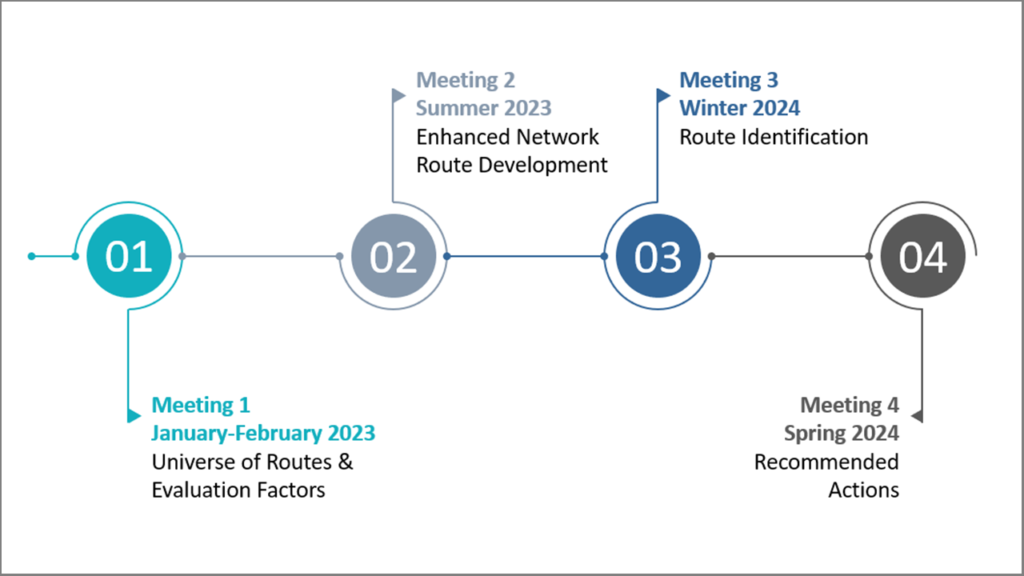
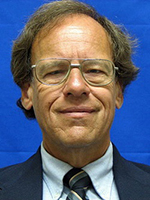
David Peter Alan is one of North America’s most experienced transit users and advocates, having ridden every rail transit line in the U.S., and most Canadian systems. He has also ridden the entire Amtrak and VIA Rail network. His advocacy on the national scene focuses on the Rail Users’ Network (RUN), where he has been a Board member since 2005. Locally in New Jersey, he served as Chair of the Lackawanna Coalition for 21 years and remains a member. He is also Chair of NJ Transit’s Senior Citizens and Disabled Residents Transportation Advisory Committee (SCDRTAC). When not writing or traveling, he practices law in the fields of Intellectual Property (Patents, Trademarks and Copyright) and business law. Opinions expressed here are his own.



